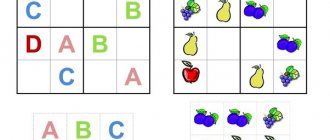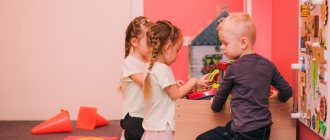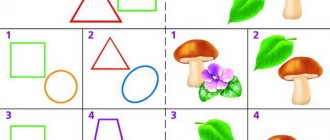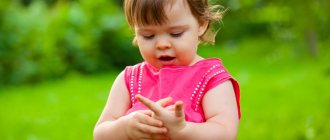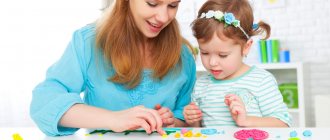Why is sensory development necessary?
The sensory development of a child involves the formation of correct perception of the external properties of various objects:
- forms;
- colors;
- sizes;
- smell;
- position in space;
- taste.
It is sensory development that is considered a tool for understanding the world around us. Outstanding specialists in the field of pedagogy and child psychology (M. Montessori, E. I. Tikheyeva, O. Dekroli, etc.) in their works considered sensory perception as one of the most important factors of intellectual development. That is, the higher the child’s sensory culture, the smarter he is.
Sensory development is a basic component for mastering many skills:
- cognitive activity;
- thinking;
- communication;
- emotional intellect;
- imagination;
- memory and concentration.
In preschool age, any child’s activity—play, cognitive, physical—requires basic sensory development. For example, in order to fold a pyramid, you need to understand the difference in the sizes of the segments, and in order to play with a construction set, you need to understand the relationship and promising combination of parts.
History of Sensory Education in Montessori
Maria Montessori was not the first teacher to draw attention to the importance of developing children's senses. When developing her approach, she relied heavily on the work of the French physician and teacher Edouard Seguin, who at one time worked with children with special needs and created his own system of exercises for developing children’s perceptions and teaching them everyday skills. Jean-Jacques Rousseau and Johann Heinrich Pestalozzi in their works also paid attention to the role of the development of sensory organs in children's learning.
Robert Baden-Powell, founder of the Scout movement and contemporary of Maria Montessori, said that to gain knowledge about the world, children need real experience of interacting with objects. This statement formed the basis of his theory of active learning. He highly valued Maria Montessori's pedagogical approach, noting that if teachers stop commanding and begin to more delicately reinforce a young child's natural need for new experiences, teachers can create a much more solid basis for subsequent learning and development. In his opinion, the idea of education as hard and exhausting work is hopelessly outdated.
Maria Montessori herself began her career working with special needs children who were deprived of adequate sensory stimulation: they had almost no toys, and their whole life was reduced to a series of basic caregiving activities. She was able to clearly prove that changing the living conditions of children significantly changes the level of their abilities. Today, the influence of the environment on a child’s development has been proven at the neurophysiological level. We recommend reading John Medin's book, Rules for Your Child's Brain Development, to become more familiar with this topic.
Maria Montessori created a system of sensory education based on many years of experience observing children and studying the works of outstanding teachers and doctors. Although she was not the first to discover the need for sensory experiences in child development, she was certainly the first educator who was able to draw public attention to this fact.
At what age to start
Numerous studies have shown that the process of sensory perception is most actively formed from 2 to 4 years. Based on surveys of parents, it was possible to find out: children with whom classes on sensory development were conducted are noticeably ahead of their peers in intellectual terms. They are more inquisitive and active, absorb information more easily, and have a good memory.
However, it is possible to develop sensory perception earlier - there are methods for the early development of children from 1 year and even earlier.
Games for developing abilities
In order for children to develop sensory abilities, there are many games and exercises:
- A game for developing tactile sensations “Recognize the figure.” Several different figures are placed in a bag, and then the same ones are laid out on the table. The teacher shows the children a figure and asks them to take the same one out of the bag. Children should find the desired figure in the bag by touch. The lesson is intended for children 3-4 years old.
- Exercise to develop auditory perception. A variety of objects are poured into several glass bottles: peas, beans, sand, pebbles, buttons, etc. Then the baby is asked to shake each bottle and draw what he heard. Children 4-5 years old do an excellent job with this task, since it is intended specifically for them.
- Exercise to develop visual perception. To do this, take any transparent object: a bottle of colored glass, a jar of colored water, a magnifying glass, etc. and ask the child to look at the indoor flower through each of these objects. Then you can ask the child to share his feelings and draw a flower, the way he saw it through these objects. The result will be several drawings, which can then be discussed. The game is designed for children 5-7 years old.
Norms of child sensory development
Despite the individual characteristics of each child, there are age-related standards for sensory development:
✓ 6-12 months. The child gets acquainted with the world around him and is enriched with impressions. During the first year of life, he learns to follow bright, moving objects. To get to know each other better, the baby grabs with his hands what is in the access zone. Tastes, examines and evaluates by touch.
✓ 2-3 years. Kids know the basic colors, shapes and sizes of objects, and have an idea of their combination. They can fold a pyramid and a sorter. Perform tasks that require the skill of grouping objects that differ from each other by 1-2 characteristics.
✓ 4-5 years. At this age, sensory standards appear - stable ideas about the colors, shapes, and sizes of surrounding objects. The child knows and distinguishes not only the basic palette, but also shades and halftones. Traces the relationship between elements of the same series, easily systematizes a large number of objects.
✓ 5-6 years. The period of development of descriptive activity. A child can characterize an object according to 3-5 parameters, draw it, and mold a prototype from plasticine. Performs complex visual actions - can tell how close or far a thing is located. He has developed analytical perception: the ability to single out the main object from similar ones, assemble a single form from many segments (construction), and combine colors under a certain condition.
There are 4 sensory perception systems. Let's look at each of them:
1. Touch (tactile perception). Trained by touching various objects/surfaces with hands and other parts of the body.
How to develop:
- give the child toys of different textures (fabric, metal, wood, plastic);
- wear clothes made from fabrics of different textures and densities. Draw the child’s attention to differences in fabrics, ask them to evaluate the level of comfort and describe the sensations of this or that clothing;
- massage using massage devices (brushes, pimply balls, massagers, creams, oils);
- draw on the body with your fingers or a brush. Allow the child to smear himself with special non-toxic water-soluble paints, and then wash them off in the bathroom;
- develop the sensitivity of the feet - walking on different surfaces without shoes, sensory mats (sewn chestnuts, pebbles, beads).
2. Vision. Trains in good lighting conditions, in daylight, on walks. The bright interior of the room, harmonious space and periodic change of environment contribute to vision training.
How to develop:
- travel a lot, visit new places, show the child various objects of infrastructure and nature: house, lake, forest, mountain, factory, sea wave, railway, etc.;
- surround the child with things of natural shades, train the perception of halftones (for example, distinguish turquoise from light blue); give pictures to look at - images of nature, animals. Show works of art, photographs. The number of details and the intricacy of plots should increase. Conventionally, for a two-year-old - a watermelon, for a five-year-old - Aivazovsky;
- learn to describe the properties of objects in the field of view, focus on colors, shapes, sizes;
- train your eye - how far away this or that object is. You can demonstrate the distance in steps, and then ask the child to mentally count the approximate number of steps to the selected object.
3. Smell and taste. The baby's diet in the first months of life is not varied, so the development of taste sensations begins with the first complementary foods - at about 6 months. Babies recognize smells from the first minutes of life. It is important to keep the air in your baby's room clean.
How to develop:
- walk more with your child, especially in the warm season, when the air is filled with the smells of flowering plants;
- replenish the child’s “database” of smells - voice them, so that later he can identify different aromas himself. For example: the smell of rain, mushrooms, soap, baking, etc.;
- introduce a variety of foods into the child’s diet, introduce new tastes;
- explain shades of tastes: sweet, bitter, sour, tart, viscous, fatty/non-fatty;
- correlate tastes with certain products, forming sensory standards: sweet raspberries, sour tangerines, salted fish, etc.;
- give the child food of different density and texture, teach the characteristics of products: the bun is sweet, soft, fluffy, aromatic.
4. Hearing. This type of sensory perception begins to form in the womb, so training can begin during pregnancy. Talk to the baby in the tummy, turn on pleasant music, avoid unpleasant, loud sounds.
How to develop:
- talk to the baby in different voices - change the timbre depending on the mood, situation;
- read fairy tales, imitating the characters’ speech;
- include a variety of music, explain its genre, give characteristics: calm, energetic, beautiful, heavy, sad; sing lullabies;
- during incidents (the child fell, fell ill), calm with your voice;
- introduce your child to musical instruments, buy him interactive sound toys;
- demonstrate what sounds household objects can make: a carrot on a grater, a comb on hair, a broom on the floor, etc.;
- learn to imitate the sounds of nature and the voices of animals and birds.
Senior preschoolers (6–7 years old)
6-7 years is a period when sensory development gains momentum with renewed vigor.
How does this happen? The child becomes more attentive.
He can already control his attention and gaze.
For example, if the attention period of a 4-5 year old child is about 6 minutes, then at 6-7 years old this period will be 10-12 minutes.
But at the same time, such children are not yet able to penetrate into the essence of things; they are still focused on the form.
Another feature of this age is the lack of differentiation of perception. The child sees only superficial information and does not yet know how to penetrate into the essence of things. This is well demonstrated by simple experience. In front of a group of children they placed 2 rows of buttons of the same size, in one row there were seven buttons, in the other 10. In the row where there were 7 buttons, under each of them they placed another one of the same size and shape. Then they asked the kids: “Which row has more buttons?” Almost all children pointed to a row of 10 buttons, since it was visually longer.
In addition, children 6-7 often confuse words that are similar in spelling and sound, but completely different in meaning, for example, “put” and “set up.” This is due to the fact that during this period their analytical function is poorly developed and it is difficult for children to analyze and perceive purposefully and in depth. The visual component still remains a priority at this stage.
As for the perception of time and space, it has its own characteristics in children of this age. They have difficulty processing large periods of time. For example, the period of dinosaurs and 80 years will be perceived by them in exactly the same way, because children do not yet have temporal abstraction.
Attention! At this stage, it is very important for the teacher to teach children to correctly perceive and evaluate spatial and temporal categories and meanings.
At home or in a development center?
There is no shortage of sensory integration specialists today. Developmental centers, correctional institutions, children's clubs, psycho-educational clinics. offer various sensory development programs for children 1-6 years old.
Advantages of their services:
- Specialists with confirmed qualifications: psychologists, teachers, special education teachers, speech therapists, etc.
- Material and technical base for comprehensive sensory development.
- Individual approach to the needs and skills of each child.
- Possibility of group classes, when sensory perception is trained during a group game.
- Professional diagnosis of the child’s abilities and assessment of progress achieved.
However, if you do not have the opportunity to attend such classes, it does not matter. Almost all types of sensory development can be implemented at home. Methodological literature and special devices will help you.
DIY didactic games
Didactic educational games do not have to be purchased in a specialized store. You can create them yourself and involve your child in the process. This will make him want to learn new things while playing. Household items that a person encounters every day are suitable as equipment. This will introduce the preschooler to everyday objects and avoid additional cash expenses.
Finger dry pool
Dry pool is a game for the development of fine motor skills, which includes finger gymnastics. Fill a deep bowl 12-15 cm high halfway with dry peas. The child dips his hands into the filler, sorts out the peas, and scatters them. In this way, self-massage of the fingers occurs.
Games in a dry pool are accompanied by music or poetry. You can put small toys at the bottom of the bowl, which you need to find and describe with your eyes closed. The game is suitable for children two to three years old.
Salt dough beads game
Children are invited to create beads as a gift for their mother from multi-colored rings. The teacher makes salt dough rings in advance and dries them in the oven. You can buy the dough at the store or make it yourself. For this you will need:
In the salt dough beads game, children string beads onto a string.
- flour - 1 glass;
- salt - 1 glass;
- starch - 1 tbsp. l.;
- water - 1 ½ cups;
- colored gouache.
Dilute starch in ½ glass of cold water, pour 1 glass of boiling water. Mix half a glass of the resulting solution with flour and salt. Knead the dough, paint it in different colors. Form rings.
During the lesson, children string beads onto a cord and form a decoration.
Guide “put the eggs in your houses”
The teacher paints a cardboard container for eggs in 4 colors: red, blue, green, yellow. Boxes of chocolate eggs (kinder surprise) are covered with appropriate colored paper. Children place colorful eggs into the appropriate cells.
"Tactile Box"
The basis of the interactive manual is a box, a saucepan, and a plastic container with a lid. It is filled with natural materials (cereals, sand, flour, shells, stones, leaves). You can add paper, cotton wool, fabric, toys to the box. The box is supplemented with tools - a spoon, spatula, glasses, muffin tins. The child studies the contents of the box, learns to manipulate different objects, and becomes familiar with various tactile sensations. You can play with the contents of the box according to the instructions of an adult or leave room for the free creativity of a preschooler.
Game "colorful sticks"
Colored counting sticks - Cuisenaire's manual. It is a set of 116 plastic sticks in 10 different colors and sizes. The smallest stick is 10 mm long, the next ones increase by 10 mm. Sticks of the same length are colored the same. Using the manual allows children to develop their understanding of numbers based on counting and measurement, form spatial concepts, and study the “more-less” relationship. You can make your own sticks or buy them at the store.
Wonderful pouch
To play you will need a large thick fabric bag and various small objects: pebbles, figures, balls and beads, coins, fabric, cones. During the game, tactile perception develops. Children take turns putting their hand into the bag and describing the object they felt. The task is to guess what item is in the bag. The lesson is carried out both individually and in a group in kindergarten.
Constructor
Construction is an activity that is aimed at creating new objects from small parts. By assembling the details of the construction set, the child develops imagination, fine motor skills, thinking, and studies colors and shapes.
An adult can offer to assemble a figure according to a model, give an oral task, or allow the child to experiment.
"Spider in the Clearing"
To play, you will need a plastic transparent bucket with a lid; holes are made in it for lacing and attaching additional parts. A spider is glued to a lid made of colored paper. The eyes are made from plastic bottle caps, painted in suitable colors, and connected to the base. Laces are added to the paws and inserted into the holes. From them the child “weaves a web.”
Small objects and ribbons are placed in the bucket, which can be pushed through holes of different diameters. There are many options for manipulating the manual, so children will come up with a new game with the spider every time.
What you will need
An approximate list of devices for the sensory development of a 2-3 year old child:
- painting supplies;
- musical instruments;
- modeling dough, soft clay, multi-colored sand;
- sorters, loose-leaf books, pyramids, nesting dolls;
- children's books, magazines;
- sensory rugs (sew chestnuts, beans, walnuts, buttons, beads, sequins onto a towel);
- pieces of fabrics of different colors and textures;
- mosaics, construction sets (“Velcro”, magnetic);
- cubes, Dienesh blocks, Cuisenaire sticks;
- objects made of different materials: wood, clay, straw, felt, steel, glass, plastic.
Games with clothespins
Clothespins are an accessible material for developing fine motor skills. To attach or unhook a clothespin, the child uses his fingers and practices exciting movements. Children under 2 years old use their entire hand to grasp, and games with clothespins will help coordinate the precise work of their fingers. Thanks to the color scheme of clothespins, you can study colors and form mathematical concepts.
Games with clothespins develop fine motor skills.
Using your imagination, you can offer your child many options for games with clothespins, including:
- Wash. Stretch a rope between two chairs and offer to hang the doll's clothes on it, securing with clothespins.
- Constructor. Using clothespins, three-dimensional figures, robots, animals, and vehicles are created.
- In the animal world. Print figurines of hedgehogs and bunnies. Attach needles in the form of clothespins to the hedgehog, and make ears out of them for the bunny.
- Polyanka. Cut out the sun, cloud, grass, tree from colored cardboard. The child attaches clothespins of the appropriate color to the stencil to create a three-dimensional picture.
- Who eats what? Print out the faces of different animals and the food they prefer. Cut a circle out of cardboard and divide it into sectors. Stick a picture of food on each one. Glue the faces onto the clothespins with tape. The child attaches clothespins with animals to the sector where suitable food is depicted.

